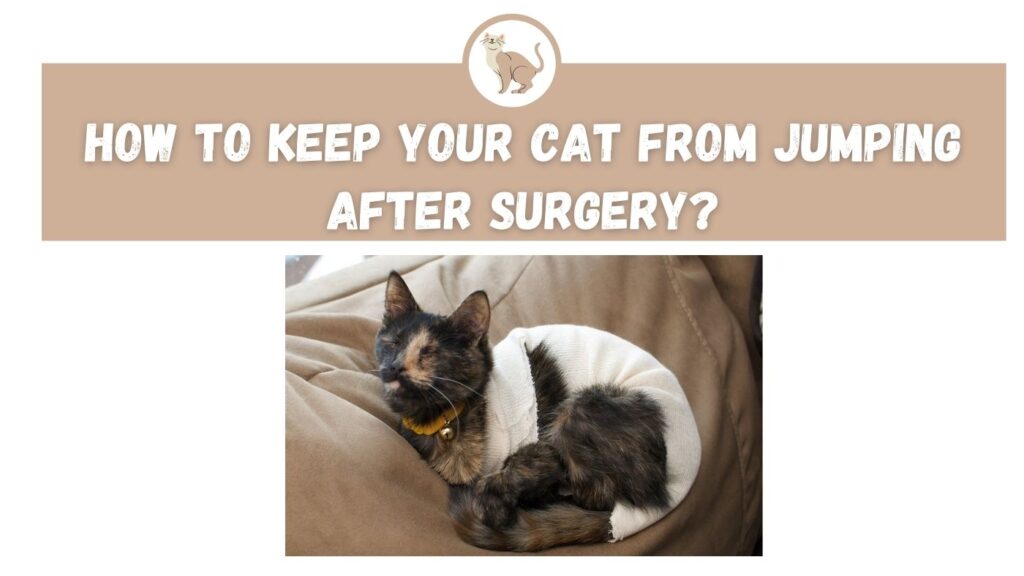Any surgery that your cat undergoes will most likely require some sort of recovery period. Whether its for a neutering, spay, bladder stones, etc., it is almost always mandatory that your cat takes it easy for a couple of days.
The main reason for this is to ensure that the stiches can heal up. If your cat is really active after a surgery, it can cause the incision to open back up, and can possibly lead to infection. One strange, but sometimes common behavior for a cat after surgery is jumping. Obviously this is not ideal, and you must take certain steps to stop this behavior.
How to keep your cat from jumping after surgery
The main ways to keep your cat from jumping after surgery is to closely monitor them, keep them inside, remove toys, isolate, avoid loud noises, use a cat calmer, and in extreme cases keep in a crate.
Closely monitor your cat
Cats are much smarter than you might think. While they might sense that you want them to take it easy after a surgery, the might go back to their old active ways the second you take your eye off of them. Therefore, it is best to keep an eye on your cat post-surgery as much as possible.
If you notice them start to get active or even start jumping, you should try to usher them back to their bed. You might even want to pick them up and hold them for a while. Cats like affection, and it can help calm them down.
Keep inside
It is also mandatory that you keep your cat inside after a surgery. There are hundreds of distractions outside, and your cat might completely forget about their surgery if they see a random squirrel. I would even limit the time they spend near the window, as they can still jump around when they see stuff outside.
Take away toys
While this sounds depressing, it is also a good idea to take away your cat’s toys for a couple days after the surgery. Your cat might get too excited when they interact with their toys, and it can cause them to run or jump around.
Similarly, if there are any object that your cat usually jumps up on, such as a desk or couch, you should cover these area to prevent your cats access from them. Similarly, you should also remove any cat trees if you have them. This will prevent your cat from jumping up on them.
Keep away other pets
Whether you have other cats or even a dog, it is very important you keep them away from your cat for a couple days. The last thing you need is for your cat to try to play and jump around with one of your other pets. I would suggest keeping your other pets in different parts of the house/apartment if possible. If your cat got spayed, you should check out my article on how long to keep cat confined after spay?
Avoid loud noises
You are probably aware that cats have very sensitive ears. Noises that seem normal to humans can be much louder for cats. If a cat is startled by a loud noise, it can cause them to run or jump around. While its impossible to avoid some sounds such as thunder, you should not play any loud music and make sure your t.v. volume is not too loud.
Cat calmer
Another great way to keep your cat from jumping after surgery is to purchase a cat calmer. These can be purchased on amazon for less than $20. They are very easy to use, as you only need to plug it into the wall. As the name suggests, it calms your cat by emitting calming aromas into the air.
I strongly suggest using this for at least a couple of days after your cat’s surgery. It will help keep your cat calm and limit their physical activity.
You can also look into my recommendations for the best over the counter cat sedatives.
Cone
While cones are more widely used for dogs, they are also a great way to help prevent your cat from jumping. Not only does the extra weight make it harder for your cat to jump, but it will also limit your cat’s interest in snooping and wandering around the house.
You should be able to get a cone from the vet, but if they don’t offer them you can easily buy them on Amazon.
Crate
Last but not least, you can also put your cat in a crate to keep them from jumping. While this is the last case resort, it is by far the best way to prevent jumping. If you do decide to put your cat in a crate, you still need to let your cat out occasionally to go to the litter box.
I would also recommend using a litter box that your cat can easily access without having to jump or climb into.
Conclusion
I hope all of the tips listed above give you good options on how to stop your cat from jumping after a surgery. It is important to remember the importance of limiting your cat’s activity after a surgery. Aside from jumping, you should also make sure they do not run a lot.
While it depends on the operation your cat had, most cats will need their activity limited for at least three days after a surgery. While these three days might require more time on your end, it can save you a lot of money if you help ensure your cat’s stiches heal properly after the operation. If your cat got spayed, you should know what a healing cat spay incision should look like.
Lastly, make sure to closely follow any and all instructions your cat’s vet tells you.

